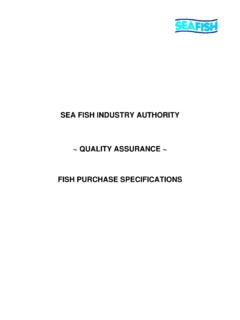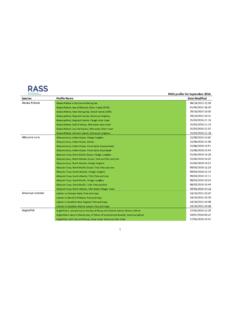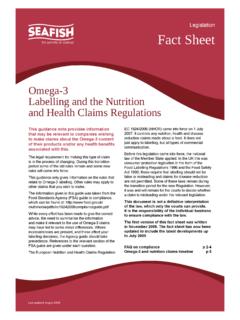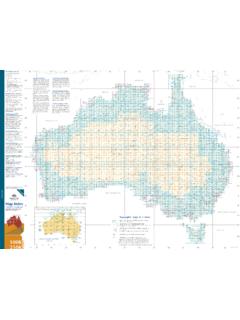Transcription of 2016INDUSTRY REPORT - Seafish
1 SEAFOOD PROCESSING INDUSTRY REPORT 2016 Seafood Processing Industry REPORT 2016 AuthorsStruan NobleMarta Moran QuintanaHazel CurtisOther ContributorsSteven LawrenceKirsten MillikenSebastien MetzArina MotovaTsvetina YordanovaMichaela ArcherJulia BrooksIvan BartoloFiona WrightLee CooperPhillip QuirieErin ForrestSean BrightAcknowledgementsMost of all, the authors would like to thank the owners and managers of seafood processing businesses for taking the time to complete questionnaires and to provide valuable survey data for this REPORT . A particular thank you goes to those who permitted site visits and willingly offered their time and industry expertise to the authors. The authors received much appreciated help and guidance from colleagues within Seafish and would especially like to thank the major contributors listed, as well as the rest of the Seafish Economics team and the temporary staff who assisted at various stages of the authors would also like to thank: Other industry stakeholders, trade associations and regional seafood bodies who provided valuable input, industry knowledge and advice during the surveys.
2 All other Seafish and Seafood Scotland colleagues who contributed their time and expertise. The Marine Management Organisation for their continued views expressed in this REPORT are those of the authors and do not necessarily represent those of the UK Government or Processing Industry REPORT 2016 CONTENTSC ontentsAcknowledgements 1 Contents 2 Executive Summary 4 Introduction Cost Structure: Summary of industry cost structure Summary of operating cost structure Summary of Inputs into Production Labour Input: Wages and labour costs Training and skills Capital Input: Fixed assets tangible and intangible Capital employed Raw Material Supply Base: Seafood Value Chain Sea fish processing raw material supply base Fish Processors: Trends in number of sites and employment Breakdown by site size Processing type Regional and home nation distribution Salmon & Freshwater Fish Processors.
3 Trends in number of sites and employment Breakdown by site size Processing type Regional and home nation distribution Sea Fish Processors: Trends in number of sites and employment Breakdown by site size Processing type Sites and jobs by fish species category Processing Industry Profile: the UK pelagic processing sector Regional and home nation distribution Labour force profile employment type & seasonality Overview of importers and exporters 26 Seafood Processing Industry REPORT 20161. Industry Structure & Employment 92. Sea Fish Processing: Cost Structure & Inputs into Production 272 Seafood Processing Industry REPORT 2016 Contents Appendix 1: Regions of the UK for Reporting Purposes 59 Appendix 2: Definitions 60 Appendix 3: Sample for Financial Estimation 63 Appendix 4: Research Approach and Methods Scope of study Research stakeholders and objectives Research methods 68 Appendix 5: Census Survey Form (2016) 70 Appendix 6: Financial Survey Form (2014) 71 Appendix 7: REPORT Data How can the industry be supported comments from industry Strengths, Weaknesses, Opportunities & Threats (SWOT) Analysis Operating Environment Raw material supplies Customer base Operating conditions: Financial climate Operating conditions: Trade Operating conditions: Regulation Operating conditions.
4 Changing international trade environment and political-economic climate Summary of Output and Productivity Summary: economic performance of the sea fish processing industry Summary: key ratios Industry Financial Output Trends Output trends turnover, operating profit and Gross Value Added Regional distribution of turnover and Gross Value Added Turnover and Gross Value Added per site by FTE band Turnover and Gross Value Added per site by FTE band Beyond Gross Value Added and Gross Domestic Product Customer Base 423. Sea Fish Processing: Output and Productivity 374. Sea Fish Processing: Industry Business Environment 43 Appendices 595: Supporting the Industry 573 Seafood Processing Industry REPORT 2016 Fish Processing: Industry 2016 profile1 INDUSTRY SIZE AND STRUCTURE (section and ): There were 376 majority fish processing sites and 17,999 Full Time Equivalent (FTE) jobs.
5 Sites with 1-25 FTE jobs made up 68% of all sites and 12% of total industry FTE jobs. Sites with over 100 FTE jobs made up 12% of all sites and provided 65% of total industry FTE PROCESSING TYPE (section ): 11,586 fish processing FTE jobs were at mixed processing sites, 4,383 FTE jobs were at secondary processing sites and 2,031 FTE jobs were at primary processing sites. Most larger processors were engaged in mixed processing, whereas most small processors (1-10 FTE jobs) were engaged in either primary or secondary HOME NATION DISTRIBUTION (section ): Just over half of sites and FTE jobs are located in England. The average size of sites in Scotland (55 FTE jobs per site) is higher than the rest of the UK. 4 REGIONAL DISTRIBUTION (section ): Humberside, Grampian and Other Scotland were the most important regions for fish processing as measured by the number of sites and FTE jobs. The largest average regional site size was in Humberside (81 FTE jobs per site), although all three regions had a higher than UK average site SALMON & FRESHWATER PROCESSORS (section ): A total of 4,445 FTE jobs were at 69 salmon & freshwater majority processing sites.
6 The average salmon & freshwater site size was larger than that of the average total fish processing industry site size. 87% of all salmon & freshwater FTE jobs were at mixed processing sites. Other Scotland (23 sites) and the Highlands and Islands (15 sites) had the largest numbers of salmon & freshwater fish processing Processing: Industry trends6 CHANGE IN INDUSTRY SIZE (section and ): The industry has consolidated with a 33% decrease in the total number of fish processing sites from 2008 to 2016. During the same period, FTE jobs per site increased by 32% to an average of 48 FTEs per site in CHANGE IN PROCESSING TYPE (section ): Between 2010 and 2016, the distribution of fish processing FTE jobs by processing type has remained CHANGE IN REGIONAL DISTRIBUTION (section ): Between 2010 and 2016, the number of sites in the top three regions decreased, in Humberside and Grampian total FTE jobs increased. South West of England showed the strongest percentage growth in number of sites (10%), and South/Midlands the strongest percentage growth in number of FTE CHANGE IN SALMON & FRESHWATER PROCESSORS (section ): Between 2010 and 2016, the number of sites classified as salmon & freshwater majority processors increased.
7 Some of this increase may be explained by processors switching focus to salmon & freshwater processing from previously processing other sea fish species. FTE jobs have varied between years with an overall decrease of just over between 2010 and SUMMARY SEAFOOD PROCESSING INDUSTRY REPORT 2016 Executive Summary 4 Seafood Processing Industry REPORT 2016 Executive Summary 10 INDUSTRY SIZE (section ): There were 13,554 FTE jobs across 307 majority sea fish processing sites, representing three quarters (75%) of all fish processing FTE jobs and 82% of all fish processing INDUSTRY STRUCTURE (section ): The sea fish industry structure was similar to overall fish processing. Over 60% of sea fish processing employment was concentrated at less than 10% of all sea fish processing PROCESSING TYPE (section ): Mixed processors made up over half of sea fish sites (54%) and FTE jobs (57%). Primary processors represented 32% of sites and 12% of FTE jobs.
8 14% of total sites were secondary processors with 31% of FTE SPECIES TYPE CATEGORY (section ): Just over half (55%) of sites processed a mix of species types and 29% of sites processed shellfish only. Most sites processing mixed species types (76%) process both sea fish species and salmon & other freshwater species. The most common species type processed at mixed species type sites was demersal (95%). 14 REGIONAL & HOME NATION DISTRIBUTION (section ): The three regions with the highest proportions of sea fish processing FTE jobs were Humberside (36%), Grampian (25%) and South West England (10%). By home nation, Scotland accounted for 35% of sea fish processing FTE jobs, England 62%, Northern Ireland 3% and Wales less than 1%.15 SEASONAL EMPLOYMENT (section ): 47 sites (17% of all sites) employed an average of 14 seasonal staff for just under 17 weeks per INDUSTRY COSTS (section and ): Total costs in 2014 amounted to 3 billion with the majority of this operating costs.
9 Raw materials were 74% of operating costs, labour costs 13%, other operating costs 12% and energy costs 2% of total operating VALUE OF INDUSTRY (section ): In 2014, total industry turnover was billion, Gross Value Added (GVA) was 554 million, operating profit was 184 million (6% of turnover) and net profit was 113 million (4% of turnover). 18 KEY FINANCIAL RATIOS (section ): In 2014, the average operating profit margin was 10% and average net profit margin was 8%. In terms of productivity, average turnover per FTE job was 233,283 and GVA per FTE job was 41,298. The industry had a current ratio of , (measure of financial health), which indicates that industry operations may be, to a degree, restricted by working capital Fish Processing: Industry profile (2016) and financial position (2014)5 Seafood Processing Industry REPORT 2016 The largest decrease in FTE jobs was in South West England (23% decrease).22 CHANGE IN INDUSTRY COSTS (section ): Between 2010 and 2014, total industry costs increased in nominal terms by , which in real terms (adjusted for inflation) would be a slight decrease.
10 The structure of operating costs remained largely steady from CHANGE IN VALUE OF ASSETS (section ): One notable change was the total value of balance sheet fixed assets, (such as equipment, premises and technology), which nearly doubled between 2010 and 2014. 24 CHANGE IN INDUSTRY VALUE (section and ): Industry turnover peaked in 2012 before nominally decreasing back to 2010 levels in 2014. GVA nominally decreased from 590 million in 2010 to 554 million in 2014, largely as a result of a decrease in operating profits (which varied over the period).25 CHANGE IN KEY RATIOS (section ): Profitability ratios decreased from 2010 to 2014. Productivity ratios varied, with turnover per FTE nominally increasing overall from 2010 to 2014 and GVA per FTE marginally decreasing. Between 2010 and 2014, estimated financial health ratios, current ratio and total debt to total assets, Fish Processing: Industry trends19 CHANGE IN INDUSTRY SIZE (section and ): The number of sea fish processing sites decreased by 37% since 2008 to 307 sites in 2016.















![[CATALOGUE TB2-CAT] TEMBREAK 2 MOULDED CASE …](/cache/preview/6/3/1/3/d/b/b/2/thumb-6313dbb2a06c3f72e0063d5e815c6636.jpg)